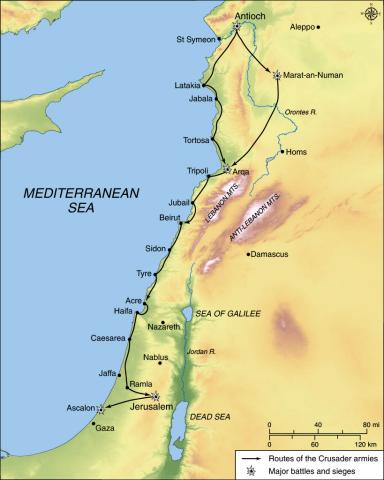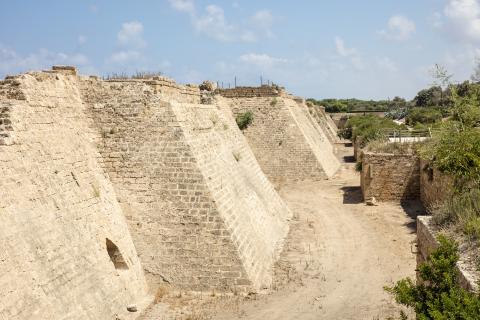The March to Jerusalem
[10.36.2] Nōs autem discessimus ab urbe in secundā fēriā mēnsis Māiī, trānsīvimusque per viam artam et arduam tōtā diē et nocte, et pervēnimus ad castrum cui nōmen Bethelon; deinde ad urbem quae dīcitur Zebārī secus mare, in quā passī sumus nimiam sitim, et sīc dēfessī pervēnimus ad flūmen cui nōmen Braym. Deinde trānsīvimus, nocte ac diē Ascēnsiōnis Dominī, per montem, in quō est via nimis angusta, et illīc putāvimus inimīcōs īnsidiantēs nōbīs invenīre, sed, Deō annuente, nūllus eōrum audēbat properāre ante nōs. Nostrī dēnique mīlitēs praecēdentēs nōs līberāvērunt ante nōs viam illam, et applicuimus ad cīvitātem iuxtā mare quae dīcitur Baruth, et inde vēnimus ad aliam urbem quae vocātur Sagitta, dehinc ad aliam, quae dīcitur Sur, et dē Sur ad Acram cīvitātem.
[10.36.3] Dē Acrā vērō vēnimus ad castrum cui nōmen Cayphās, ac deinceps hospitātī sumus iuxtā Caesarēam, ibique celebrāvimus Pentēcostēn, tertiā diē exeunte Māiō. Dēnique vēnimus ad urbem Ramola, quam Saracēnī dīmīserant vacuam propter metum Francōrum. Iuxtā quam erat honōrābilis ecclēsia in quā requiēvit pretiōsissimum sānctī Georgīī corpus, quia illīc ā perfidīs pāgānīs prō Chrīstī nōmine fēlīciter martyrium suscēpit. Ibi cōnsiliātī sunt nostrī māiōrēs ut illīc ēligerent epīscopum, quī hanc cūstōdīret et ērigeret ecclēsiam. Cui suās dedērunt decimās, et aurō argentōque dītāvērunt, et equīs ac animālibus aliīs, quō dēvōtē et honestē vīveret cum illīs quī cum eō essent.
notes
vocabulary
10.36.2
artus –a –um: narrow
secus: alongside, next to (prep. + acc.)
sitis –is, f.: thirst
annuō (adnuō) (3): to nod to, assent
properō (1): to make haste, to hasten, be quick
applicō (1): to tie up at (of ships) (CL); arrive at (ML)
10.36.3
metus –ūs, m.: fear, dread, terror
perfidus –a –um: dishonest, treacherous
decima –ae, f.: a tenth part, tithe


